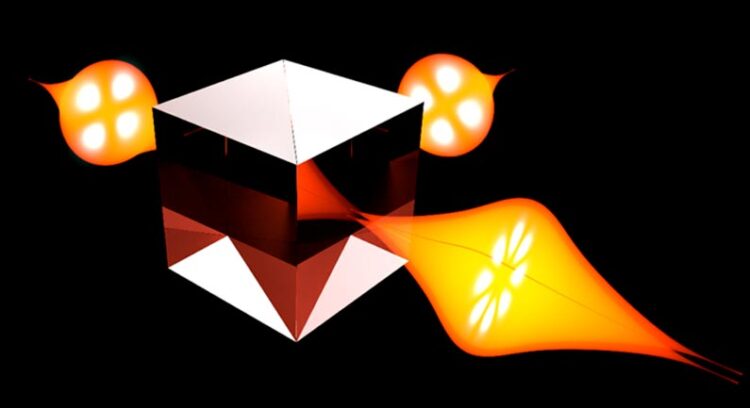Photon pairs are more sensitive to rotations than single photons

Conceptual image displaying the input photons bunching into a two-photon structure made visible through post-selecting on the two photons coexisting in the same transverse position.
Credit: Markus Hiekkamäki / Tampere University
In the field of quantum metrology, scientists are developing novel measurement schemes that benefit from quantum features and are more precise and sensitive than classical conventional methods. The team of researchers from Tampere University, Finland, and the National Research Council of Canada has now shown how a simple and powerful technique called two-photon N00N states can be used to create spatially structured quantum states of light that can go beyond the classical limit in rotation estimation. The results are published in the prestigious journal Physical Review Letters.
“Our experimental results demonstrate a simple but powerful way of custom-tailoring two-photon quantum states and holds promise for applications that can achieve high measurement precisions.The simplicity of our method opens a path to creating a measurement system that beats the classical estimation limit with current technologies”, explains Doctoral Researcher and lead author Markus Hiekkamäki.
Measurement precisions at the absolute quantum limit
The method utilizes a fundamental quantum feature, i.e., the interference between two photons, which is often termed photon bunching. In contrast to the more common photon bunching into the same physical path, the novel scheme leads to a bunching into the same spatial structure.
“In our case, the quantum interference results in an entangled state of two photons. Because of the quantum nature of the realized state, the entangled photon pair gives a better measurement precision when compared to the same spatial shape imprinted on a similar amount of single photons or laser light. Using a counter-intuitive quantum response, we were able to show that it will be possible to achieve measurement precisions at the absolute quantum limit “, says Associate Professor Robert Fickler, leader of the Experimental Quantum Optics group at Tampere University.
Besides rotational measurements, the method allows the generation of a large variety of different quantum states for transverse-spatial modes. Hence, it could also be utilized in measurements of many different types of systems as well as in fundamental tests of multi-photon quantum states of light.
After demonstrating the advantage in rotational estimation, the researchers are now planning on using the method to shed new light on another fundamental property of waves called the Gouy phase. In addition, they study how it could be extended into quantum-enhanced measurement schemes in multiple degrees of freedom.
Read the article Photonic Angular Superresolution Using Twisted N00N States in Physical Review Letters.
Journal: Physical Review
DOI: 10.1103/PhysRevLett.127.263601
Method of Research: News article
Subject of Research: Not applicable
Article Title: Photonic Angular Superresolution Using Twisted N00N States
Article Publication Date: 23-Dec-2021
All latest news from the category: Physics and Astronomy
This area deals with the fundamental laws and building blocks of nature and how they interact, the properties and the behavior of matter, and research into space and time and their structures.
innovations-report provides in-depth reports and articles on subjects such as astrophysics, laser technologies, nuclear, quantum, particle and solid-state physics, nanotechnologies, planetary research and findings (Mars, Venus) and developments related to the Hubble Telescope.
Newest articles

Combatting disruptive ‘noise’ in quantum communication
In a significant milestone for quantum communication technology, an experiment has demonstrated how networks can be leveraged to combat disruptive ‘noise’ in quantum communications. The international effort led by researchers…

Stretchable quantum dot display
Intrinsically stretchable quantum dot-based light-emitting diodes achieved record-breaking performance. A team of South Korean scientists led by Professor KIM Dae-Hyeong of the Center for Nanoparticle Research within the Institute for…

Internet can achieve quantum speed with light saved as sound
Researchers at the University of Copenhagen’s Niels Bohr Institute have developed a new way to create quantum memory: A small drum can store data sent with light in its sonic…





















